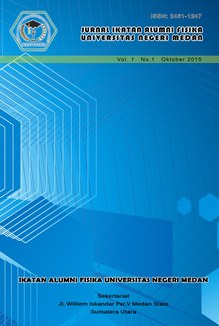PENGARUH MODEL PEMBELAJARAN GUIDED DISCOVERY MENGGUNAKAN MEDIA PETA PIKIRAN TERHADAP HASIL BELAJAR SISWA PADA MATERI POKOK LISTRIK DINAMIS DI KELAS X SEMESTER GENAP SMA CERDAS MURNI TEMBUNG T.P 2014/2015
DOI:
https://doi.org/10.24114/jiaf.v1i1.2687Abstract
Penelitian ini bertujuan untuk mengetahui hasil belajar siswa pada ranah kognitif, afektif, dan psikomotorik serta aktivitas siswa dengan menggunakan model pembelajaran guided discovery menggunakan media peta pikiran pada materi pokok listrik dinamis. Metode penelitian adalah quasi eksperimen dengan populasi seluruh siswa kelas X Semester Genap SMA Cerdas Murni Tembung yang terdiri dari 3 kelas. Sampel penelitian diambil 2 kelas yang ditentukan dengan teknik cluster random sampling, dengan kelas X MIA2 sebagai kelas eksperimen dan kelas X MIA1 sebagai kelas kontrol. Selama proses pembelajaran, nilai rata-sata hasil belajar siswa adalah. Berdasarkan uji t dapat disimpulkan bahwa ada pengaruh penerapan model pembelajaran guided discovery menggunakan media peta pikiran terhadap hasil belajar siswa pada materi pokok listrik dinamis.References
Akanmu, M.A., & Fajamidagba, M.O., (2013), Guided-discovery Learning Strategy and Senior School Student Performance in Mathematic in Ejigbo Nigeria.Journal of Education and Practice 4: 82-89.
Arikunto,S., (2009), Dasar-Dasar Evaluasi Pendidikan, Bumi Aksara, Jakarta.
Arikunto, S., (2010), Prosedur Penelitian, Remaja Rosda Karya, Bandung.
Bruner, J.S., (1960), The Process of Education, Harvard University Press, Cambridge.
Sugiyono., (2009), Metode Penelitian Kuantitatif, Kualitatif dan R & D, Penerbit Alfabeta, Bandung.
Syah, M., (1996).Psikologi Pendidikan Suatu Pendekatan Baru, PT Remaja Rosdakarya, Bandung.
Trianto.,(2009), Mendesain Model Pembelajaran Inovatif-Progresif, Prestasi Pustaka, Jakarta.
Zulhelmi., (2009), Penilaian Psikomotor dan Respon Siswa dalam Pembelajaran Sains Fisika Melalui Penerapan Penemuan Terbimbing di SMA Negeri 20 Pekanbaru, Jurnal Geliga Sains 3 : 8-13.
Downloads
Published
Issue
Section
License
Authors who publish with this journal agree to the following terms:- Authors retain copyright and grant the journal right of first publication with the work simultaneously licensed under a Creative Commons Attribution License that allows others to share the work with an acknowledgement of the work's authorship and initial publication in this journal.
- Authors are able to enter into separate, additional contractual arrangements for the non-exclusive distribution of the journal's published version of the work (e.g., post it to an institutional repository or publish it in a book), with an acknowledgement of its initial publication in this journal.
- Authors are permitted and encouraged to post their work online (e.g., in institutional repositories or on their website) prior to and during the submission process, as it can lead to productive exchanges, as well as earlier and greater citation of published work (See The Effect of Open Access).

